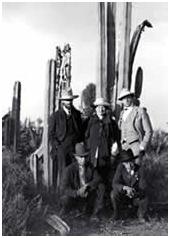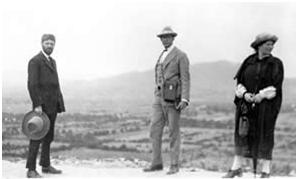Round the World
Ceylon proved hot and in most ways a disappointment; Lawrence wrote little, which was unusual for him, except letters and his translation of Giovanni Verga; but a previously unconsidered diversion to Australia, provoked by contacts made on the voyage to Colombo, led to an unexpected and (in terms of writing) immensely worthwhile visit. After a brief stay in Western Australia, where they met the writer Mollie Skinner, the Lawrences settled on the coast south of Sydney, at Thirroul; and here, in six weeks, Lawrence wrote his novel Kangaroo, drawing upon his experience of Europe in the new context of Australia; the long chapter 'The Nightmare' was a retrospective on what had happened to him during the war, and how his central figure Richard Somers now felt 'without a people, without a land. So be it. He was broken apart, apart he would remain'.
In Australia the Lawrences saw almost no-one; in America they were plunged into activity after activity. After meeting the poet Witter Bynner and his companion Willard ('Spud') Johnson in Santa Fe, Mabel Sterne and her Indian lover Tony took them around by car from Taos; they visited an Apache reservation and Taos Pueblo, saw Indian dances, and Mabel did her best to persuade Lawrence to write both about her and about the American southwest (part of her mission in bringing him there). Lawrence and Frieda both reacted strongly against her, however, and spent the winter of 1922-23 at the Del Monte ranch on Lobo Mountain, out of the orbit of Mabel so far as they could manage it; two Danish painter friends (Knud Merrild and Kai Götzsche) lived with them. While up at the ranch, Lawrence managed a final reworking of the much-revised Studies, shortening and Americanising them in accordance with his new experience. He also finished his poetry collection Birds, Beasts and Flowers. In the spring of 1923, the Lawrences went down to Mexico with Bynner and Johnson; they visited historical sites, ending up living beside Lake Chapala; and here Lawrence began Quetzalcoatl, the novel of the American continent which he had not managed to write in Taos. This first draft of what would become The Plumed Serpent occupied him until he and Frieda decided they should go to New York, to see Seltzer (currently publishing book after book by Lawrence) and in order to go back to Europe; Frieda was especially anxious to see her children, as two of them were now aged 21 or over, and she could see them freely for the first time since 1912. Lawrence however could not face Europe and stayed behind in America, after one of their most serious quarrels. After a few months wandering down the west coast in the company of Götzsche (and turning a novel by Mollie Skinner into one for which he was equally responsible, The Boy in the Bush) he resolved to return briefly to Europe. He was only in England for a couple of months; but in a traumatic and significant move, having invited his London friends to dinner at the Café Royal, he invited them to come back to New Mexico with him and Frieda. Dorothy Brett was the only one to accept (Middleton Murry said yes but meant no) and – after Lawrence and Frieda had been to Germany to see Frieda's mother (of whom he was increasingly fond) – Brett accompanied the Lawrences back to America in March 1924.

Lawrence and Frieda in Mexico (Lawrence Collection)
This time they resolved to live the life of the ranch from the start; and on a small and partly derelict property given to Frieda by Mabel (Lawrence insisted on paying for it with the manuscript of Sons and Lovers ) they spent an extremely busy time getting the cabins ready; and then, with the hard physical work done, Lawrence devoted himself to writing. In an extraordinarily short space of time he produced three of his greatest works of the American continent: St. Mawr , 'The Woman Who Rode Away' and 'The Princess'. His work was however succeeded, in August, by his first bronchial haemorrhage, perhaps aggravated by the altitude of over 7000 feet; when he was better, all three of them went down to Mexico in October, where Lawrence wanted to finish The Plumed Serpent. They settled in Oaxaca, a far less Europeanised town than Chapala.

Lawrence and friends in Mexico (Lawrence Collection)
He wrote the whole novel again – composing his Mornings in Mexico essays in the interim, as a kind of light relief – but at a dreadful cost of health and spirits; no sooner had he completed the novel than he went down with a combination of typhoid and pneumonia, and back in Mexico City a doctor diagnosed him as suffering from tuberculosis. He and Frieda had planned to return to England, but this doctor advised altitude, and they struggled back up to the ranch.
Amazingly, over the summer of 1925 Lawrence recovered much of his health, though he was never so well as he had been during the strenuous spring and summer of 1924; he compiled the essays in Reflections on the Death of a Porcupine, and also wrote his last play David. On the ranch, well away from civilisation, the Lawrences and Brett lived close to the wildness of nature, although such a life was necessarily always a struggle. Lawrence would write in an essay of 1928 how 'New Mexico was the greatest experience from the outside world that I have ever had'. They were limited in how long they could stay in the USA, however, and in September he and Frieda travelled back to Europe, Lawrence always hoping he would be able to return to the ranch.
© Professor John Worthen, 2005
Next chapter: Struggle